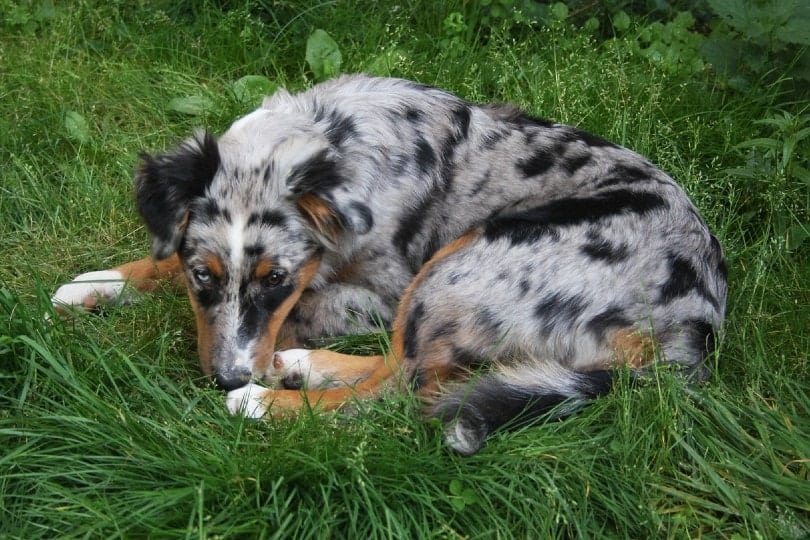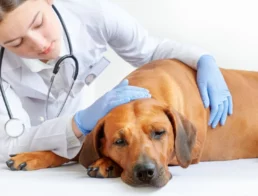Unfortunately, hip dysplasia is quite a common affliction for many dogs. While it tends to affect giant and large breeds most often, dogs of almost any size can be susceptible to it. If your dog has been newly diagnosed or you’re worried about a future diagnosis, you might be wondering how a dog can live with hip dysplasia.
Fortunately, hip dysplasia is not a death sentence. It does require physiotherapy, pain relief medication, and possibly surgery with regular checkups with your vet, but your dog can still live a happy and long life.
Here, we go over the symptoms of hip dysplasia, how it’s treated, and what you can do to help your dog live the fullest life possible.
What Exactly Is Hip Dysplasia and How Do They Get It?
Hip dysplasia is caused by genetics and tends to be hereditary, but there are other factors involved. The hip joint is a ball and socket, which are supposed to fit snugly and move smoothly together without any friction.
With hip dysplasia, the joint doesn’t develop the right way. The ball and socket end up fitting together loosely, and since the joint is loose, the leg bone joint moves, which causes grinding. The joint eventually deteriorates and can stop functioning altogether. This also causes a great deal of pain.
Other factors that can lead to hip dysplasia, besides genetics, are improper diet and exercise. A dog not receiving the right nutrition in their diet or getting too much or too little exercise can factor in the development of hip dysplasia.
Obesity is another physical factor that can increase the risk for dogs that are already predisposed to hip dysplasia. In some cases, obesity alone can lead to hip dysplasia.
This condition also tends to begin while the dog is growing, which is also why large breeds, particularly puppies, are prone to hip dysplasia.
The most commonly afflicted dog breeds are the German Shepherd, Labrador Retriever, and Golden Retriever. However, many large breeds are susceptible to the condition.

What Are the Symptoms of Hip Dysplasia?
Dogs are good at hiding pain, so they might be hiding the signs of hip dysplasia until it becomes a serious problem. If you notice your dog acting differently or walking in an unusual way, it’s always best to have your vet check them out.
Signs that your dog might have hip dysplasia are:
- Stiffness when getting up
- Difficulty climbing stairs
- Limping and bunny-hopping
- Avoiding exercise
- Whining
- Growling
- Flinching when touched on the hindquarters
- Signs of pain when sitting down or getting up
If your dog is showing obvious signs of pain, this usually means the pain has reached high levels, and your vet needs to step in.
How Is Hip Dysplasia Treated?
Your vet will start by looking for signs of hip dysplasia through a physical exam and testing the flexibility of the joint. They will take an X-ray to determine how severe the condition is, which will impact the kind of treatment that your dog will receive.
It might be managed with pain medication and physiotherapy alone if caught early enough.
If your dog is obese, they will need to lose weight with a diet change, as weight management is essential. Your vet might recommend a prescription dog food that can aid joint health.
Reduced exercise is also important so as not to antagonize the condition. Physiotherapy can improve the dog’s mobility, which can be accomplished with activities like swimming or other low-impact exercises.
In some cases, acupuncture might be recommended, which can help strengthen the muscles and range of mobility and decrease pain.
Your vet might decide that surgery is a viable option, but this would only occur after a complete orthopedic evaluation.

Can Hip Dysplasia Be Prevented?
There is currently no known way to prevent hip dysplasia, particularly since it is predominantly a hereditary condition. If you have a large breed puppy, you can provide them with joint supplements starting at 3 months of age and stay on top of your pup’s weight.
Also, bring your dog to see the vet regularly in order to hopefully catch the hip dysplasia before it becomes a serious problem.
Conclusion
While many different breeds can end up with hip dysplasia, large breeds are more likely to inherit this condition. See your vet immediately if you notice your dog struggling to walk or any other worrisome symptoms. The combination of a healthy and balanced diet, weight management, and moderate exercise can help your dog live a full and happy life.
Featured Image Credit: Shutterstock














